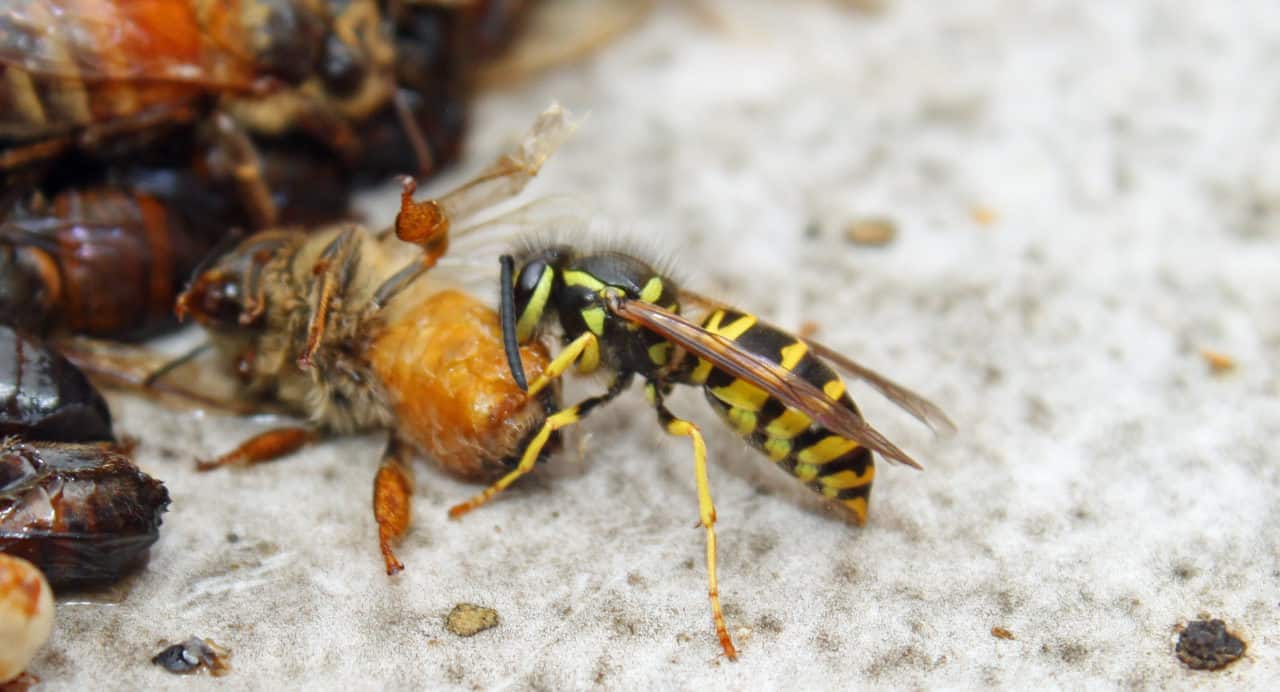With winter approaching and food sources dwindling honey bee colonies are starting to be harassed by pests. Yellow Jackets are one of the most common pests, they feed on bees, larva, brood, honey bee bread and pretty much anything they can take advantage of in the hive. During this time of year when robbing becomes a problem, the yellow jackets will follow. During the chaos there is an open opportunity for yellow jackets to move in and take advantage of the situation. In Butte County, CA it was a very dry year so the yellow jackets will be a more serious problem with the lack of forage and resources for them.

Beekeepers have a few choices to try to combat these ferocious predators. You can set up bait traps that are available commercially or you can construct you own. You can easily construct a trap using 2L bottles and filling the bottom with sugar syrup (an inch or so). You can use other things as bait such as meat, fish, chicken or rotting fruit if you are trapping a lot of honey . Sugar syrup is the easiest to dispose of and the same trap can be used over repeatedly with rinsing. You can either keep the bottle whole or cut the top third of the bottle off and flip it so the small open part of the bottle is pointed down. It should look like a funnel; this allows wasps to get in but makes it hard for them to get out. This method works much better than just a plain bottle with syrup in it.
Another thing beekeepers do is place entrance reducers on their hives; this limits the space that guard bees have to protect. If it is still warm in your area, it may be best to use a screen reducer to ensure proper ventilation. You can check my previous blog on entrance reducers for images. Also duct tape any holes in the hive bodies or lids. You can also staple small screen over the holes.
For the more ambitious beekeepers I have some solutions to find the source of the problem. Yellow Jacket nests are usually found close to the source of food. The nests are in the ground in old rodent burrows. The following procedure steps through how to coat wasps with powdered sugar to track them. To find the nest, get a plastic cup, preferably clear (glass works too). Now find something to place over the top of the cup that is thick enough so that the wasp cannot sting through it (coasters work great). The next step is personal preference; I put confectioners’ sugar into the cup before catching the wasp. Some will put the confectioners’ sugar in afterwards but then you run the risk of the wasp or wasps escaping. You can now head out to the yard. It is best to do this in the morning before honey bees are in full forage and when it is cooler. Once you catch a wasp in your cup you want to give it one shake to cover the wasp with the sugar. You can now let the wasp go and watch where it flies. It will hopefully fly back to its nest. The powder sugar helps you see the wasp when it flies away; it also helps distinguish it from flying honey bees. You may need to do this a few times with several wasps before you find the nest. This does not always work and if I don’t find them within 30 minutes or so I give up and just hope the traps take care of a majority of the wasps. I will sometimes do 20-30 wasps and walk around and look for white wasp activity near the ground.

If you do happen to find the nest there are a few tricks to kill them. You can take a pot of boiling water dump it down the nest entrance. It is best to do this at night to ensure most of the wasps are present in the nest and to avoid being stung. If you don’t have access to boiling water you can spray the entrance with a registered insecticide. Do not seal the entrance of the nest if you use the insecticide, this allows for other wasps that may have stayed out to come in contact with the insecticide. It is also best to use this at night. Avoid using a headlamp because the wasps will come for the light if they do come out of the nest. If they do come out, turn the light off and walk away, once the lights gone you will be ok. Another tip I recently heard was to place a bucket over the hole and let it there for several days. If on an uneven surface, use a folded towel to ensure the entrance is completely sealed. I have not tried this method but if anyone does, please comment with the outcome.
